A Detailed Comparison of RAS and DAS: Remote Access Strategies
VerifiedAdded on 2023/06/13
|12
|2896
|375
Essay
AI Summary
This essay provides a detailed comparison of Remote Access Strategy (RAS) and Direct Access Strategy (DAS), focusing on their functionalities, advantages, disadvantages, and response times within an organizational context requiring remote connections. It highlights that RAS allows access to computer systems from remote locations via LAN, WAN, or VPN, while DAS enables direct access to physical records stored discretely. The discussion covers how RAS provides allowances, acknowledges interruptions, builds connections, excludes communication, and offers a common environment, whereas DAS provides intranet connectivity and establishes IPsec tunnels. The analysis extends to the pros and cons of each strategy, noting RAS's responsiveness in emergencies and easier network connections, but also its higher cost and security vulnerabilities, while DAS offers ease of deployment and secure VPNs but is limited to IPv6 and specific Windows Server versions. Ultimately, the essay concludes that DAS offers lower response times and higher security, making it a preferable strategy for organizations prioritizing these aspects.
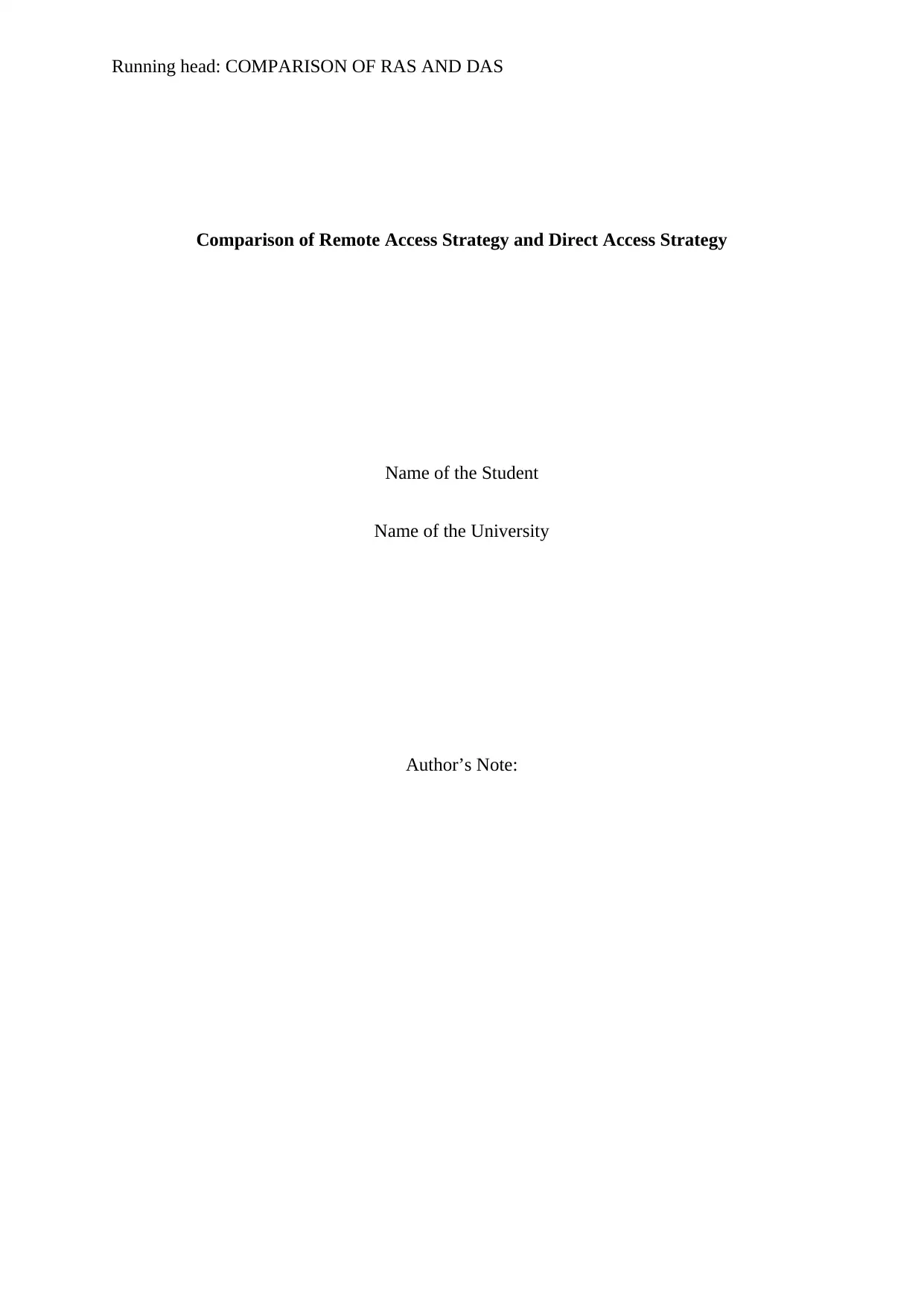
Running head: COMPARISON OF RAS AND DAS
Comparison of Remote Access Strategy and Direct Access Strategy
Name of the Student
Name of the University
Author’s Note:
Comparison of Remote Access Strategy and Direct Access Strategy
Name of the Student
Name of the University
Author’s Note:
Paraphrase This Document
Need a fresh take? Get an instant paraphrase of this document with our AI Paraphraser
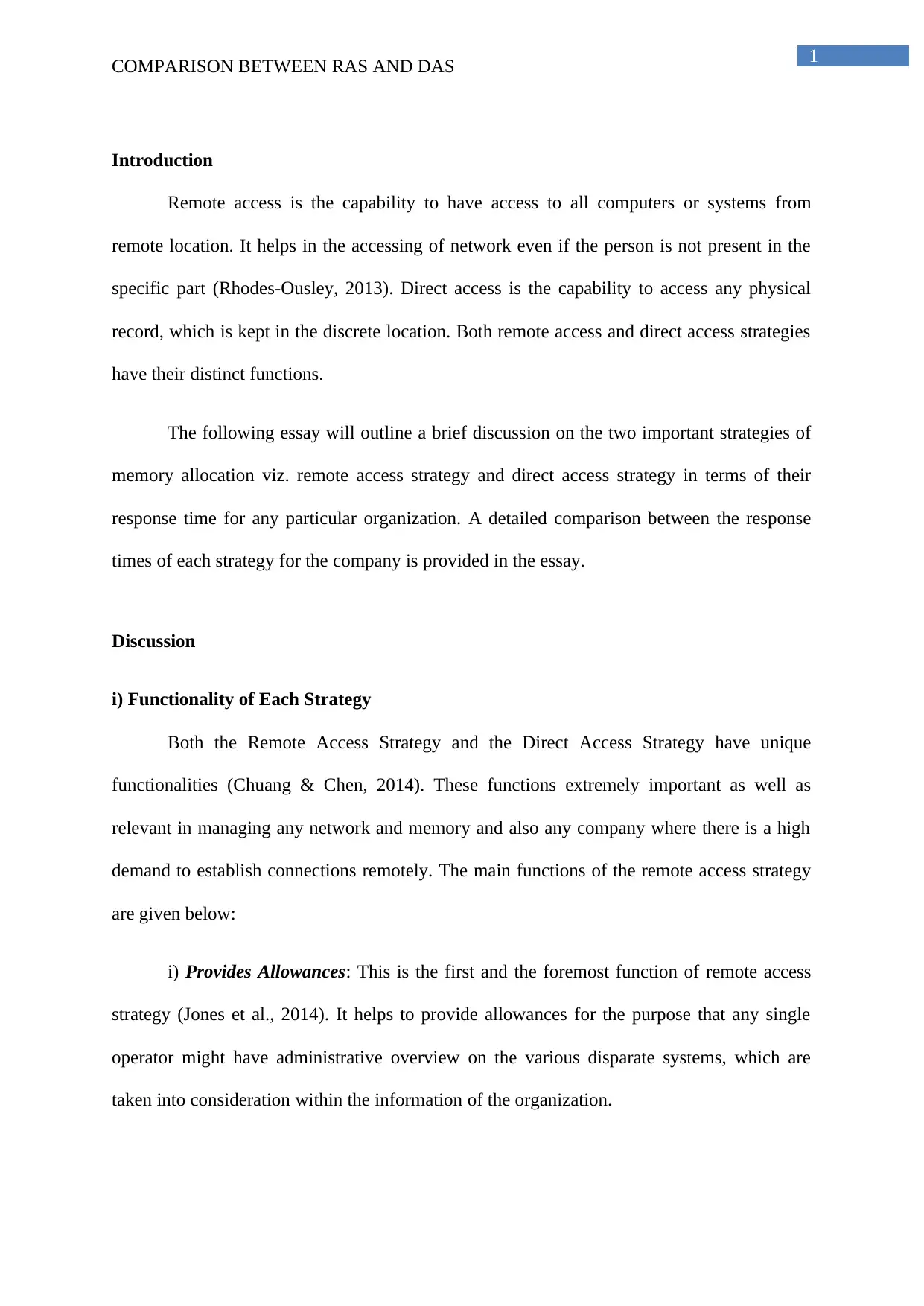
1
COMPARISON BETWEEN RAS AND DAS
Introduction
Remote access is the capability to have access to all computers or systems from
remote location. It helps in the accessing of network even if the person is not present in the
specific part (Rhodes-Ousley, 2013). Direct access is the capability to access any physical
record, which is kept in the discrete location. Both remote access and direct access strategies
have their distinct functions.
The following essay will outline a brief discussion on the two important strategies of
memory allocation viz. remote access strategy and direct access strategy in terms of their
response time for any particular organization. A detailed comparison between the response
times of each strategy for the company is provided in the essay.
Discussion
i) Functionality of Each Strategy
Both the Remote Access Strategy and the Direct Access Strategy have unique
functionalities (Chuang & Chen, 2014). These functions extremely important as well as
relevant in managing any network and memory and also any company where there is a high
demand to establish connections remotely. The main functions of the remote access strategy
are given below:
i) Provides Allowances: This is the first and the foremost function of remote access
strategy (Jones et al., 2014). It helps to provide allowances for the purpose that any single
operator might have administrative overview on the various disparate systems, which are
taken into consideration within the information of the organization.
COMPARISON BETWEEN RAS AND DAS
Introduction
Remote access is the capability to have access to all computers or systems from
remote location. It helps in the accessing of network even if the person is not present in the
specific part (Rhodes-Ousley, 2013). Direct access is the capability to access any physical
record, which is kept in the discrete location. Both remote access and direct access strategies
have their distinct functions.
The following essay will outline a brief discussion on the two important strategies of
memory allocation viz. remote access strategy and direct access strategy in terms of their
response time for any particular organization. A detailed comparison between the response
times of each strategy for the company is provided in the essay.
Discussion
i) Functionality of Each Strategy
Both the Remote Access Strategy and the Direct Access Strategy have unique
functionalities (Chuang & Chen, 2014). These functions extremely important as well as
relevant in managing any network and memory and also any company where there is a high
demand to establish connections remotely. The main functions of the remote access strategy
are given below:
i) Provides Allowances: This is the first and the foremost function of remote access
strategy (Jones et al., 2014). It helps to provide allowances for the purpose that any single
operator might have administrative overview on the various disparate systems, which are
taken into consideration within the information of the organization.
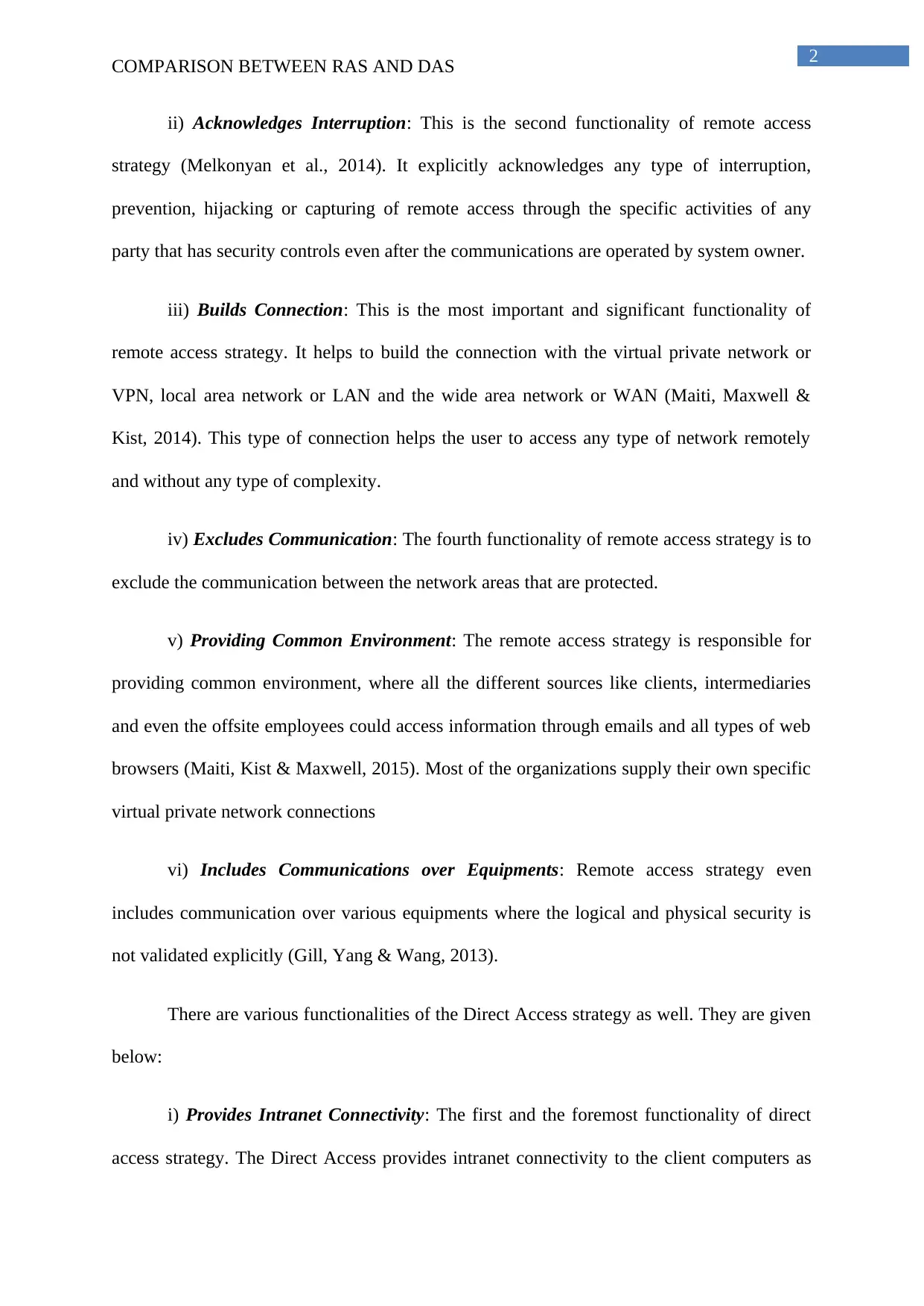
2
COMPARISON BETWEEN RAS AND DAS
ii) Acknowledges Interruption: This is the second functionality of remote access
strategy (Melkonyan et al., 2014). It explicitly acknowledges any type of interruption,
prevention, hijacking or capturing of remote access through the specific activities of any
party that has security controls even after the communications are operated by system owner.
iii) Builds Connection: This is the most important and significant functionality of
remote access strategy. It helps to build the connection with the virtual private network or
VPN, local area network or LAN and the wide area network or WAN (Maiti, Maxwell &
Kist, 2014). This type of connection helps the user to access any type of network remotely
and without any type of complexity.
iv) Excludes Communication: The fourth functionality of remote access strategy is to
exclude the communication between the network areas that are protected.
v) Providing Common Environment: The remote access strategy is responsible for
providing common environment, where all the different sources like clients, intermediaries
and even the offsite employees could access information through emails and all types of web
browsers (Maiti, Kist & Maxwell, 2015). Most of the organizations supply their own specific
virtual private network connections
vi) Includes Communications over Equipments: Remote access strategy even
includes communication over various equipments where the logical and physical security is
not validated explicitly (Gill, Yang & Wang, 2013).
There are various functionalities of the Direct Access strategy as well. They are given
below:
i) Provides Intranet Connectivity: The first and the foremost functionality of direct
access strategy. The Direct Access provides intranet connectivity to the client computers as
COMPARISON BETWEEN RAS AND DAS
ii) Acknowledges Interruption: This is the second functionality of remote access
strategy (Melkonyan et al., 2014). It explicitly acknowledges any type of interruption,
prevention, hijacking or capturing of remote access through the specific activities of any
party that has security controls even after the communications are operated by system owner.
iii) Builds Connection: This is the most important and significant functionality of
remote access strategy. It helps to build the connection with the virtual private network or
VPN, local area network or LAN and the wide area network or WAN (Maiti, Maxwell &
Kist, 2014). This type of connection helps the user to access any type of network remotely
and without any type of complexity.
iv) Excludes Communication: The fourth functionality of remote access strategy is to
exclude the communication between the network areas that are protected.
v) Providing Common Environment: The remote access strategy is responsible for
providing common environment, where all the different sources like clients, intermediaries
and even the offsite employees could access information through emails and all types of web
browsers (Maiti, Kist & Maxwell, 2015). Most of the organizations supply their own specific
virtual private network connections
vi) Includes Communications over Equipments: Remote access strategy even
includes communication over various equipments where the logical and physical security is
not validated explicitly (Gill, Yang & Wang, 2013).
There are various functionalities of the Direct Access strategy as well. They are given
below:
i) Provides Intranet Connectivity: The first and the foremost functionality of direct
access strategy. The Direct Access provides intranet connectivity to the client computers as
⊘ This is a preview!⊘
Do you want full access?
Subscribe today to unlock all pages.

Trusted by 1+ million students worldwide
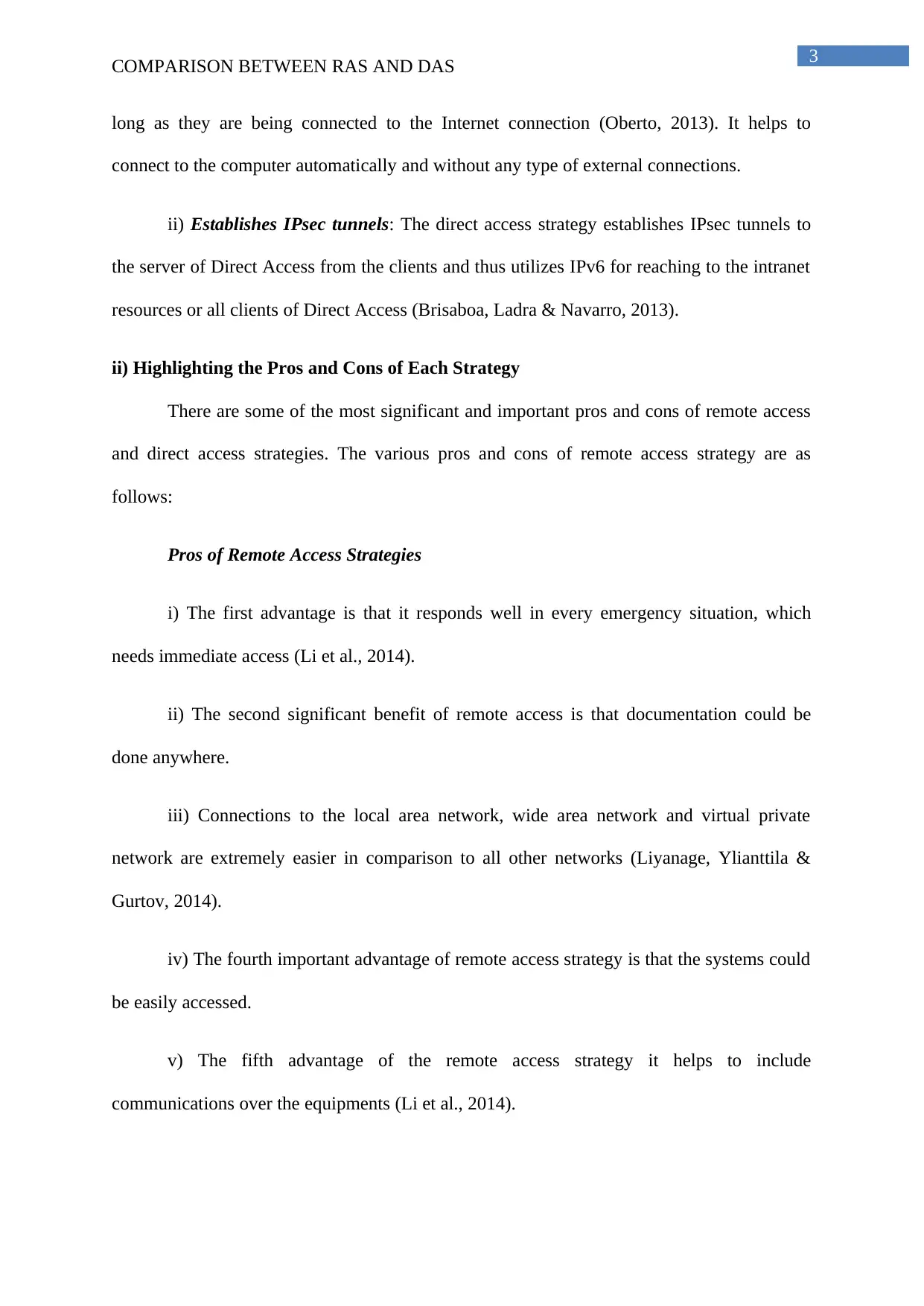
3
COMPARISON BETWEEN RAS AND DAS
long as they are being connected to the Internet connection (Oberto, 2013). It helps to
connect to the computer automatically and without any type of external connections.
ii) Establishes IPsec tunnels: The direct access strategy establishes IPsec tunnels to
the server of Direct Access from the clients and thus utilizes IPv6 for reaching to the intranet
resources or all clients of Direct Access (Brisaboa, Ladra & Navarro, 2013).
ii) Highlighting the Pros and Cons of Each Strategy
There are some of the most significant and important pros and cons of remote access
and direct access strategies. The various pros and cons of remote access strategy are as
follows:
Pros of Remote Access Strategies
i) The first advantage is that it responds well in every emergency situation, which
needs immediate access (Li et al., 2014).
ii) The second significant benefit of remote access is that documentation could be
done anywhere.
iii) Connections to the local area network, wide area network and virtual private
network are extremely easier in comparison to all other networks (Liyanage, Ylianttila &
Gurtov, 2014).
iv) The fourth important advantage of remote access strategy is that the systems could
be easily accessed.
v) The fifth advantage of the remote access strategy it helps to include
communications over the equipments (Li et al., 2014).
COMPARISON BETWEEN RAS AND DAS
long as they are being connected to the Internet connection (Oberto, 2013). It helps to
connect to the computer automatically and without any type of external connections.
ii) Establishes IPsec tunnels: The direct access strategy establishes IPsec tunnels to
the server of Direct Access from the clients and thus utilizes IPv6 for reaching to the intranet
resources or all clients of Direct Access (Brisaboa, Ladra & Navarro, 2013).
ii) Highlighting the Pros and Cons of Each Strategy
There are some of the most significant and important pros and cons of remote access
and direct access strategies. The various pros and cons of remote access strategy are as
follows:
Pros of Remote Access Strategies
i) The first advantage is that it responds well in every emergency situation, which
needs immediate access (Li et al., 2014).
ii) The second significant benefit of remote access is that documentation could be
done anywhere.
iii) Connections to the local area network, wide area network and virtual private
network are extremely easier in comparison to all other networks (Liyanage, Ylianttila &
Gurtov, 2014).
iv) The fourth important advantage of remote access strategy is that the systems could
be easily accessed.
v) The fifth advantage of the remote access strategy it helps to include
communications over the equipments (Li et al., 2014).
Paraphrase This Document
Need a fresh take? Get an instant paraphrase of this document with our AI Paraphraser
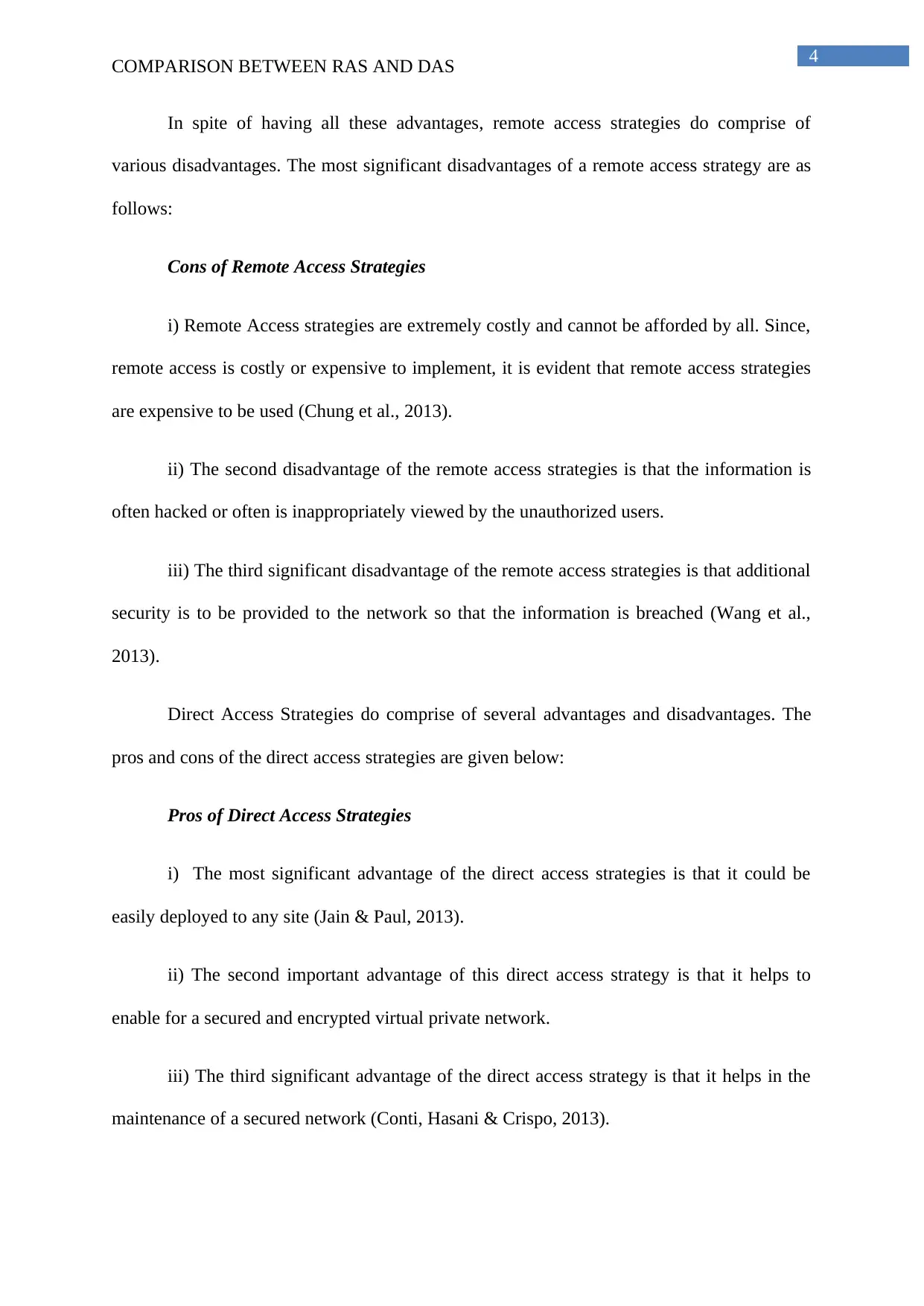
4
COMPARISON BETWEEN RAS AND DAS
In spite of having all these advantages, remote access strategies do comprise of
various disadvantages. The most significant disadvantages of a remote access strategy are as
follows:
Cons of Remote Access Strategies
i) Remote Access strategies are extremely costly and cannot be afforded by all. Since,
remote access is costly or expensive to implement, it is evident that remote access strategies
are expensive to be used (Chung et al., 2013).
ii) The second disadvantage of the remote access strategies is that the information is
often hacked or often is inappropriately viewed by the unauthorized users.
iii) The third significant disadvantage of the remote access strategies is that additional
security is to be provided to the network so that the information is breached (Wang et al.,
2013).
Direct Access Strategies do comprise of several advantages and disadvantages. The
pros and cons of the direct access strategies are given below:
Pros of Direct Access Strategies
i) The most significant advantage of the direct access strategies is that it could be
easily deployed to any site (Jain & Paul, 2013).
ii) The second important advantage of this direct access strategy is that it helps to
enable for a secured and encrypted virtual private network.
iii) The third significant advantage of the direct access strategy is that it helps in the
maintenance of a secured network (Conti, Hasani & Crispo, 2013).
COMPARISON BETWEEN RAS AND DAS
In spite of having all these advantages, remote access strategies do comprise of
various disadvantages. The most significant disadvantages of a remote access strategy are as
follows:
Cons of Remote Access Strategies
i) Remote Access strategies are extremely costly and cannot be afforded by all. Since,
remote access is costly or expensive to implement, it is evident that remote access strategies
are expensive to be used (Chung et al., 2013).
ii) The second disadvantage of the remote access strategies is that the information is
often hacked or often is inappropriately viewed by the unauthorized users.
iii) The third significant disadvantage of the remote access strategies is that additional
security is to be provided to the network so that the information is breached (Wang et al.,
2013).
Direct Access Strategies do comprise of several advantages and disadvantages. The
pros and cons of the direct access strategies are given below:
Pros of Direct Access Strategies
i) The most significant advantage of the direct access strategies is that it could be
easily deployed to any site (Jain & Paul, 2013).
ii) The second important advantage of this direct access strategy is that it helps to
enable for a secured and encrypted virtual private network.
iii) The third significant advantage of the direct access strategy is that it helps in the
maintenance of a secured network (Conti, Hasani & Crispo, 2013).
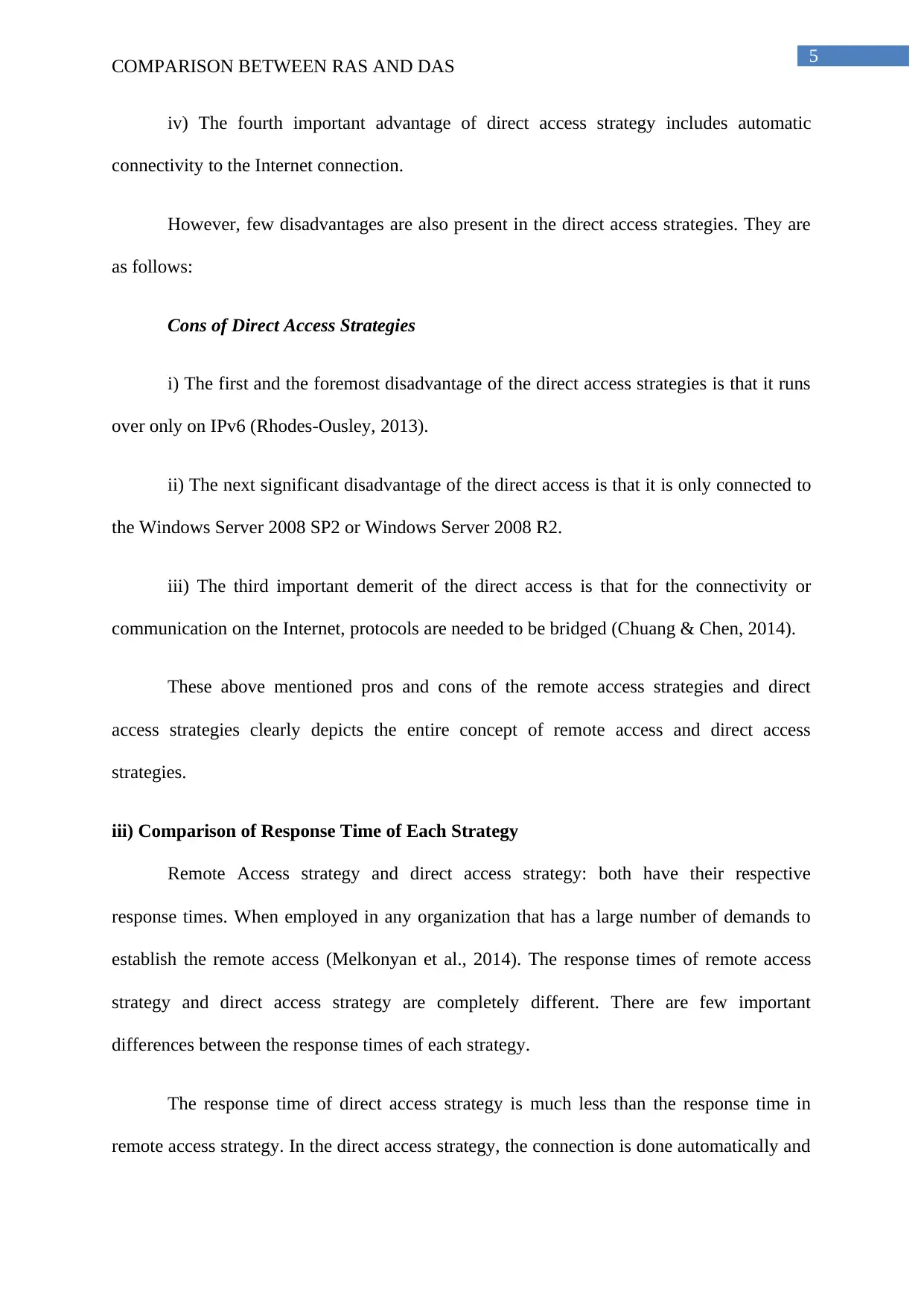
5
COMPARISON BETWEEN RAS AND DAS
iv) The fourth important advantage of direct access strategy includes automatic
connectivity to the Internet connection.
However, few disadvantages are also present in the direct access strategies. They are
as follows:
Cons of Direct Access Strategies
i) The first and the foremost disadvantage of the direct access strategies is that it runs
over only on IPv6 (Rhodes-Ousley, 2013).
ii) The next significant disadvantage of the direct access is that it is only connected to
the Windows Server 2008 SP2 or Windows Server 2008 R2.
iii) The third important demerit of the direct access is that for the connectivity or
communication on the Internet, protocols are needed to be bridged (Chuang & Chen, 2014).
These above mentioned pros and cons of the remote access strategies and direct
access strategies clearly depicts the entire concept of remote access and direct access
strategies.
iii) Comparison of Response Time of Each Strategy
Remote Access strategy and direct access strategy: both have their respective
response times. When employed in any organization that has a large number of demands to
establish the remote access (Melkonyan et al., 2014). The response times of remote access
strategy and direct access strategy are completely different. There are few important
differences between the response times of each strategy.
The response time of direct access strategy is much less than the response time in
remote access strategy. In the direct access strategy, the connection is done automatically and
COMPARISON BETWEEN RAS AND DAS
iv) The fourth important advantage of direct access strategy includes automatic
connectivity to the Internet connection.
However, few disadvantages are also present in the direct access strategies. They are
as follows:
Cons of Direct Access Strategies
i) The first and the foremost disadvantage of the direct access strategies is that it runs
over only on IPv6 (Rhodes-Ousley, 2013).
ii) The next significant disadvantage of the direct access is that it is only connected to
the Windows Server 2008 SP2 or Windows Server 2008 R2.
iii) The third important demerit of the direct access is that for the connectivity or
communication on the Internet, protocols are needed to be bridged (Chuang & Chen, 2014).
These above mentioned pros and cons of the remote access strategies and direct
access strategies clearly depicts the entire concept of remote access and direct access
strategies.
iii) Comparison of Response Time of Each Strategy
Remote Access strategy and direct access strategy: both have their respective
response times. When employed in any organization that has a large number of demands to
establish the remote access (Melkonyan et al., 2014). The response times of remote access
strategy and direct access strategy are completely different. There are few important
differences between the response times of each strategy.
The response time of direct access strategy is much less than the response time in
remote access strategy. In the direct access strategy, the connection is done automatically and
⊘ This is a preview!⊘
Do you want full access?
Subscribe today to unlock all pages.

Trusted by 1+ million students worldwide
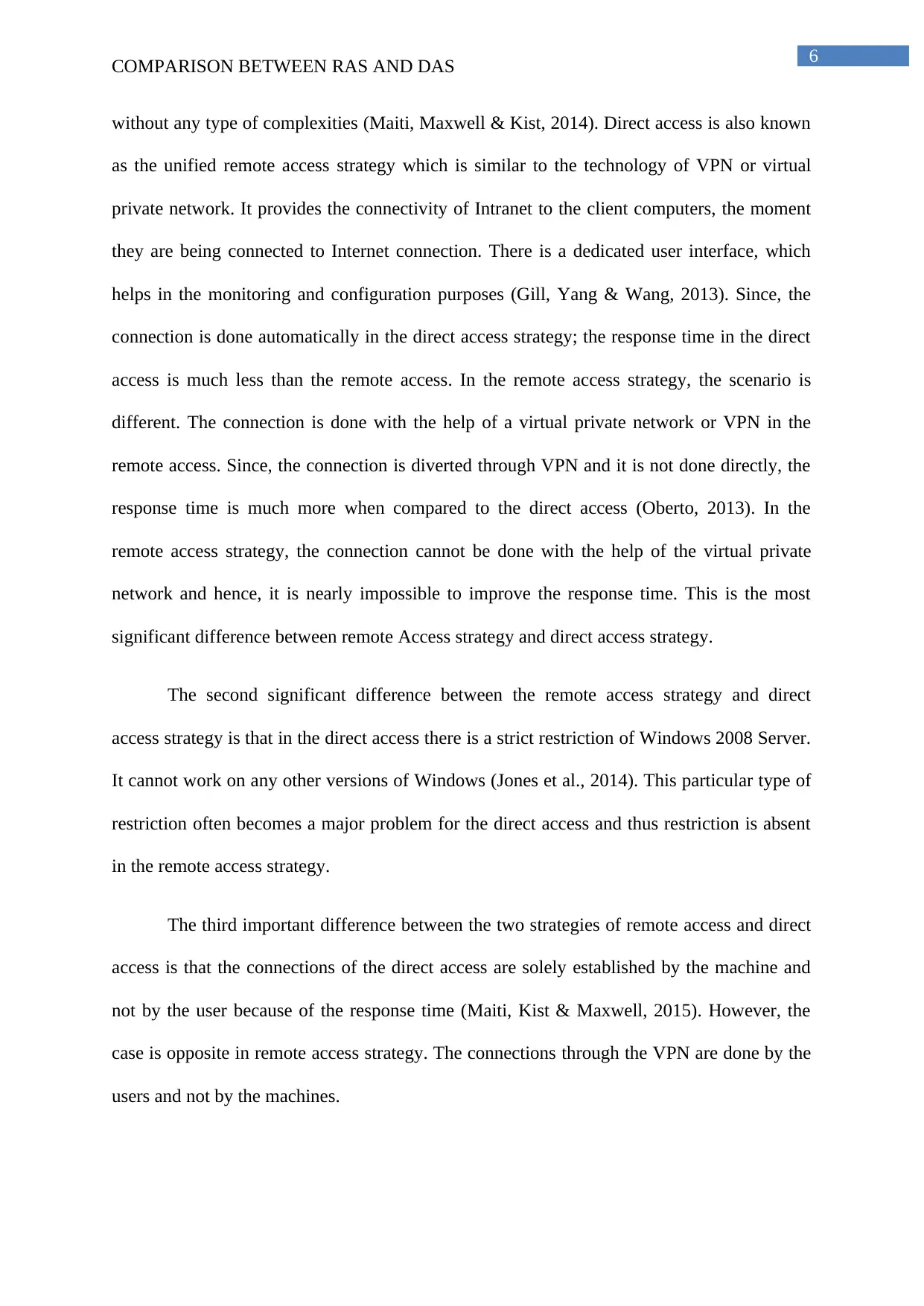
6
COMPARISON BETWEEN RAS AND DAS
without any type of complexities (Maiti, Maxwell & Kist, 2014). Direct access is also known
as the unified remote access strategy which is similar to the technology of VPN or virtual
private network. It provides the connectivity of Intranet to the client computers, the moment
they are being connected to Internet connection. There is a dedicated user interface, which
helps in the monitoring and configuration purposes (Gill, Yang & Wang, 2013). Since, the
connection is done automatically in the direct access strategy; the response time in the direct
access is much less than the remote access. In the remote access strategy, the scenario is
different. The connection is done with the help of a virtual private network or VPN in the
remote access. Since, the connection is diverted through VPN and it is not done directly, the
response time is much more when compared to the direct access (Oberto, 2013). In the
remote access strategy, the connection cannot be done with the help of the virtual private
network and hence, it is nearly impossible to improve the response time. This is the most
significant difference between remote Access strategy and direct access strategy.
The second significant difference between the remote access strategy and direct
access strategy is that in the direct access there is a strict restriction of Windows 2008 Server.
It cannot work on any other versions of Windows (Jones et al., 2014). This particular type of
restriction often becomes a major problem for the direct access and thus restriction is absent
in the remote access strategy.
The third important difference between the two strategies of remote access and direct
access is that the connections of the direct access are solely established by the machine and
not by the user because of the response time (Maiti, Kist & Maxwell, 2015). However, the
case is opposite in remote access strategy. The connections through the VPN are done by the
users and not by the machines.
COMPARISON BETWEEN RAS AND DAS
without any type of complexities (Maiti, Maxwell & Kist, 2014). Direct access is also known
as the unified remote access strategy which is similar to the technology of VPN or virtual
private network. It provides the connectivity of Intranet to the client computers, the moment
they are being connected to Internet connection. There is a dedicated user interface, which
helps in the monitoring and configuration purposes (Gill, Yang & Wang, 2013). Since, the
connection is done automatically in the direct access strategy; the response time in the direct
access is much less than the remote access. In the remote access strategy, the scenario is
different. The connection is done with the help of a virtual private network or VPN in the
remote access. Since, the connection is diverted through VPN and it is not done directly, the
response time is much more when compared to the direct access (Oberto, 2013). In the
remote access strategy, the connection cannot be done with the help of the virtual private
network and hence, it is nearly impossible to improve the response time. This is the most
significant difference between remote Access strategy and direct access strategy.
The second significant difference between the remote access strategy and direct
access strategy is that in the direct access there is a strict restriction of Windows 2008 Server.
It cannot work on any other versions of Windows (Jones et al., 2014). This particular type of
restriction often becomes a major problem for the direct access and thus restriction is absent
in the remote access strategy.
The third important difference between the two strategies of remote access and direct
access is that the connections of the direct access are solely established by the machine and
not by the user because of the response time (Maiti, Kist & Maxwell, 2015). However, the
case is opposite in remote access strategy. The connections through the VPN are done by the
users and not by the machines.
Paraphrase This Document
Need a fresh take? Get an instant paraphrase of this document with our AI Paraphraser
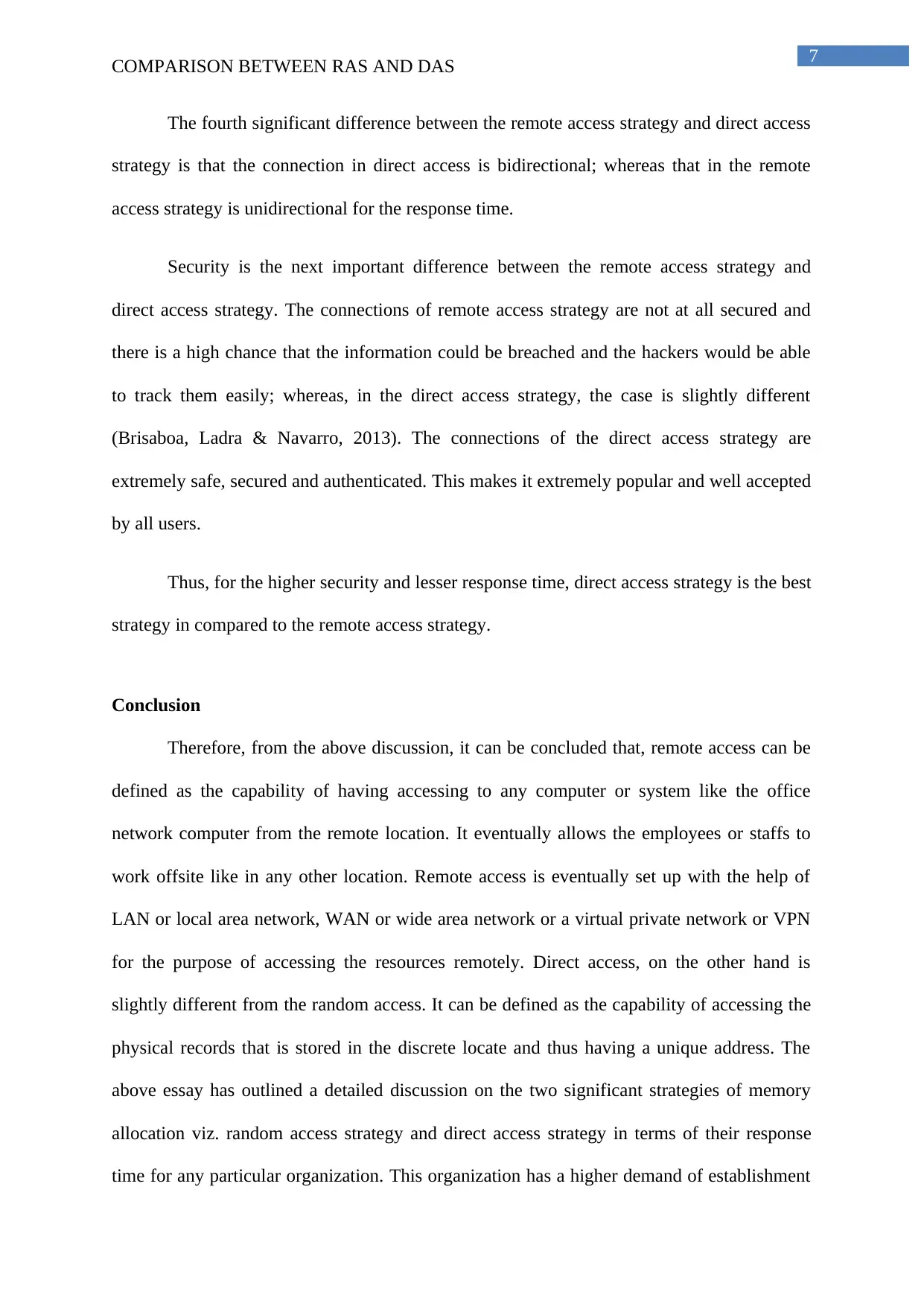
7
COMPARISON BETWEEN RAS AND DAS
The fourth significant difference between the remote access strategy and direct access
strategy is that the connection in direct access is bidirectional; whereas that in the remote
access strategy is unidirectional for the response time.
Security is the next important difference between the remote access strategy and
direct access strategy. The connections of remote access strategy are not at all secured and
there is a high chance that the information could be breached and the hackers would be able
to track them easily; whereas, in the direct access strategy, the case is slightly different
(Brisaboa, Ladra & Navarro, 2013). The connections of the direct access strategy are
extremely safe, secured and authenticated. This makes it extremely popular and well accepted
by all users.
Thus, for the higher security and lesser response time, direct access strategy is the best
strategy in compared to the remote access strategy.
Conclusion
Therefore, from the above discussion, it can be concluded that, remote access can be
defined as the capability of having accessing to any computer or system like the office
network computer from the remote location. It eventually allows the employees or staffs to
work offsite like in any other location. Remote access is eventually set up with the help of
LAN or local area network, WAN or wide area network or a virtual private network or VPN
for the purpose of accessing the resources remotely. Direct access, on the other hand is
slightly different from the random access. It can be defined as the capability of accessing the
physical records that is stored in the discrete locate and thus having a unique address. The
above essay has outlined a detailed discussion on the two significant strategies of memory
allocation viz. random access strategy and direct access strategy in terms of their response
time for any particular organization. This organization has a higher demand of establishment
COMPARISON BETWEEN RAS AND DAS
The fourth significant difference between the remote access strategy and direct access
strategy is that the connection in direct access is bidirectional; whereas that in the remote
access strategy is unidirectional for the response time.
Security is the next important difference between the remote access strategy and
direct access strategy. The connections of remote access strategy are not at all secured and
there is a high chance that the information could be breached and the hackers would be able
to track them easily; whereas, in the direct access strategy, the case is slightly different
(Brisaboa, Ladra & Navarro, 2013). The connections of the direct access strategy are
extremely safe, secured and authenticated. This makes it extremely popular and well accepted
by all users.
Thus, for the higher security and lesser response time, direct access strategy is the best
strategy in compared to the remote access strategy.
Conclusion
Therefore, from the above discussion, it can be concluded that, remote access can be
defined as the capability of having accessing to any computer or system like the office
network computer from the remote location. It eventually allows the employees or staffs to
work offsite like in any other location. Remote access is eventually set up with the help of
LAN or local area network, WAN or wide area network or a virtual private network or VPN
for the purpose of accessing the resources remotely. Direct access, on the other hand is
slightly different from the random access. It can be defined as the capability of accessing the
physical records that is stored in the discrete locate and thus having a unique address. The
above essay has outlined a detailed discussion on the two significant strategies of memory
allocation viz. random access strategy and direct access strategy in terms of their response
time for any particular organization. This organization has a higher demand of establishment

8
COMPARISON BETWEEN RAS AND DAS
of remote connection. The essay has even highlighted on the functionalities of these two
strategies with relevant details. Moreover, the pros and cons of each of the two strategies will
also be given here. The essay has also given a comparison between the two strategies.
COMPARISON BETWEEN RAS AND DAS
of remote connection. The essay has even highlighted on the functionalities of these two
strategies with relevant details. Moreover, the pros and cons of each of the two strategies will
also be given here. The essay has also given a comparison between the two strategies.
⊘ This is a preview!⊘
Do you want full access?
Subscribe today to unlock all pages.

Trusted by 1+ million students worldwide
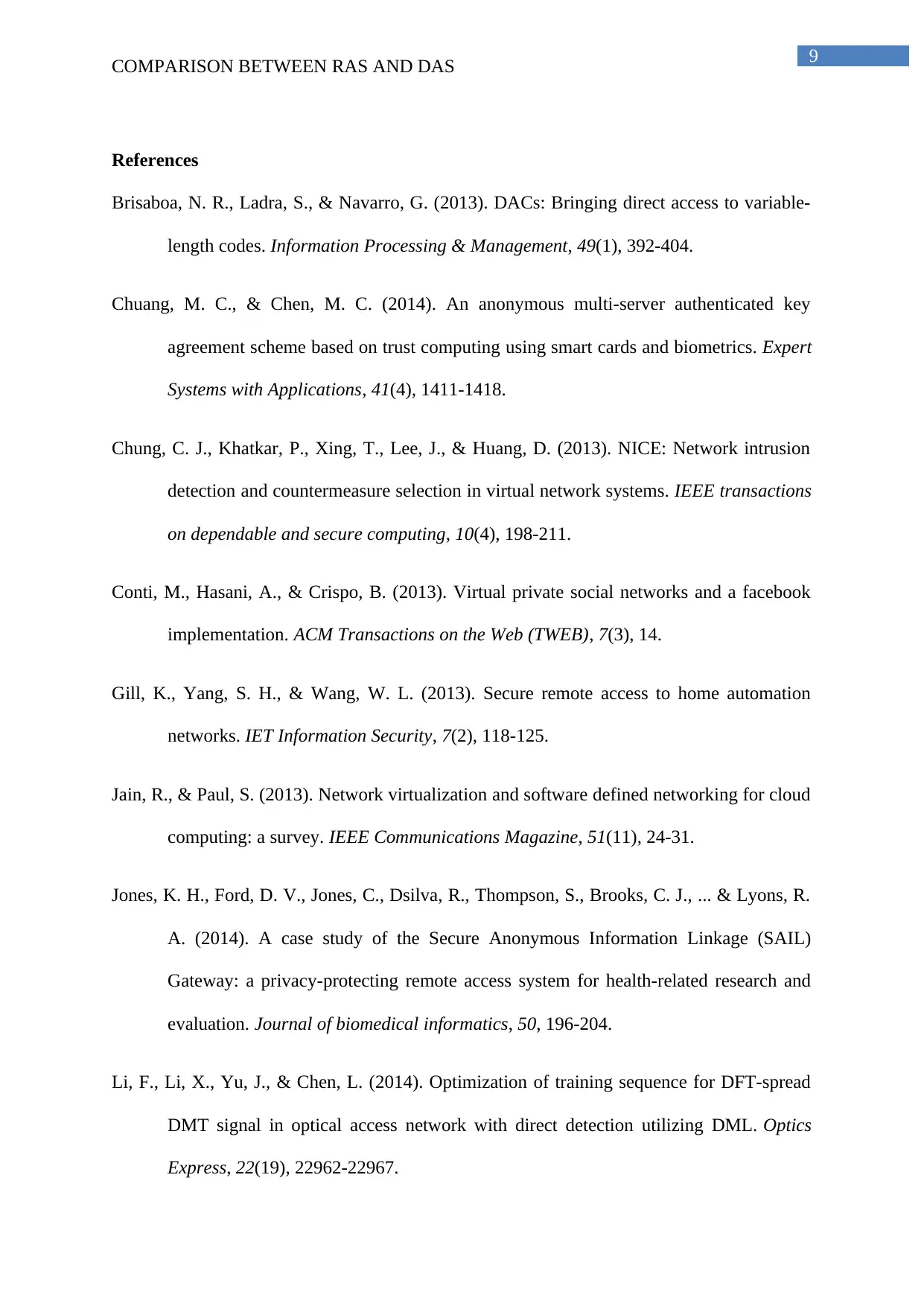
9
COMPARISON BETWEEN RAS AND DAS
References
Brisaboa, N. R., Ladra, S., & Navarro, G. (2013). DACs: Bringing direct access to variable-
length codes. Information Processing & Management, 49(1), 392-404.
Chuang, M. C., & Chen, M. C. (2014). An anonymous multi-server authenticated key
agreement scheme based on trust computing using smart cards and biometrics. Expert
Systems with Applications, 41(4), 1411-1418.
Chung, C. J., Khatkar, P., Xing, T., Lee, J., & Huang, D. (2013). NICE: Network intrusion
detection and countermeasure selection in virtual network systems. IEEE transactions
on dependable and secure computing, 10(4), 198-211.
Conti, M., Hasani, A., & Crispo, B. (2013). Virtual private social networks and a facebook
implementation. ACM Transactions on the Web (TWEB), 7(3), 14.
Gill, K., Yang, S. H., & Wang, W. L. (2013). Secure remote access to home automation
networks. IET Information Security, 7(2), 118-125.
Jain, R., & Paul, S. (2013). Network virtualization and software defined networking for cloud
computing: a survey. IEEE Communications Magazine, 51(11), 24-31.
Jones, K. H., Ford, D. V., Jones, C., Dsilva, R., Thompson, S., Brooks, C. J., ... & Lyons, R.
A. (2014). A case study of the Secure Anonymous Information Linkage (SAIL)
Gateway: a privacy-protecting remote access system for health-related research and
evaluation. Journal of biomedical informatics, 50, 196-204.
Li, F., Li, X., Yu, J., & Chen, L. (2014). Optimization of training sequence for DFT-spread
DMT signal in optical access network with direct detection utilizing DML. Optics
Express, 22(19), 22962-22967.
COMPARISON BETWEEN RAS AND DAS
References
Brisaboa, N. R., Ladra, S., & Navarro, G. (2013). DACs: Bringing direct access to variable-
length codes. Information Processing & Management, 49(1), 392-404.
Chuang, M. C., & Chen, M. C. (2014). An anonymous multi-server authenticated key
agreement scheme based on trust computing using smart cards and biometrics. Expert
Systems with Applications, 41(4), 1411-1418.
Chung, C. J., Khatkar, P., Xing, T., Lee, J., & Huang, D. (2013). NICE: Network intrusion
detection and countermeasure selection in virtual network systems. IEEE transactions
on dependable and secure computing, 10(4), 198-211.
Conti, M., Hasani, A., & Crispo, B. (2013). Virtual private social networks and a facebook
implementation. ACM Transactions on the Web (TWEB), 7(3), 14.
Gill, K., Yang, S. H., & Wang, W. L. (2013). Secure remote access to home automation
networks. IET Information Security, 7(2), 118-125.
Jain, R., & Paul, S. (2013). Network virtualization and software defined networking for cloud
computing: a survey. IEEE Communications Magazine, 51(11), 24-31.
Jones, K. H., Ford, D. V., Jones, C., Dsilva, R., Thompson, S., Brooks, C. J., ... & Lyons, R.
A. (2014). A case study of the Secure Anonymous Information Linkage (SAIL)
Gateway: a privacy-protecting remote access system for health-related research and
evaluation. Journal of biomedical informatics, 50, 196-204.
Li, F., Li, X., Yu, J., & Chen, L. (2014). Optimization of training sequence for DFT-spread
DMT signal in optical access network with direct detection utilizing DML. Optics
Express, 22(19), 22962-22967.
Paraphrase This Document
Need a fresh take? Get an instant paraphrase of this document with our AI Paraphraser
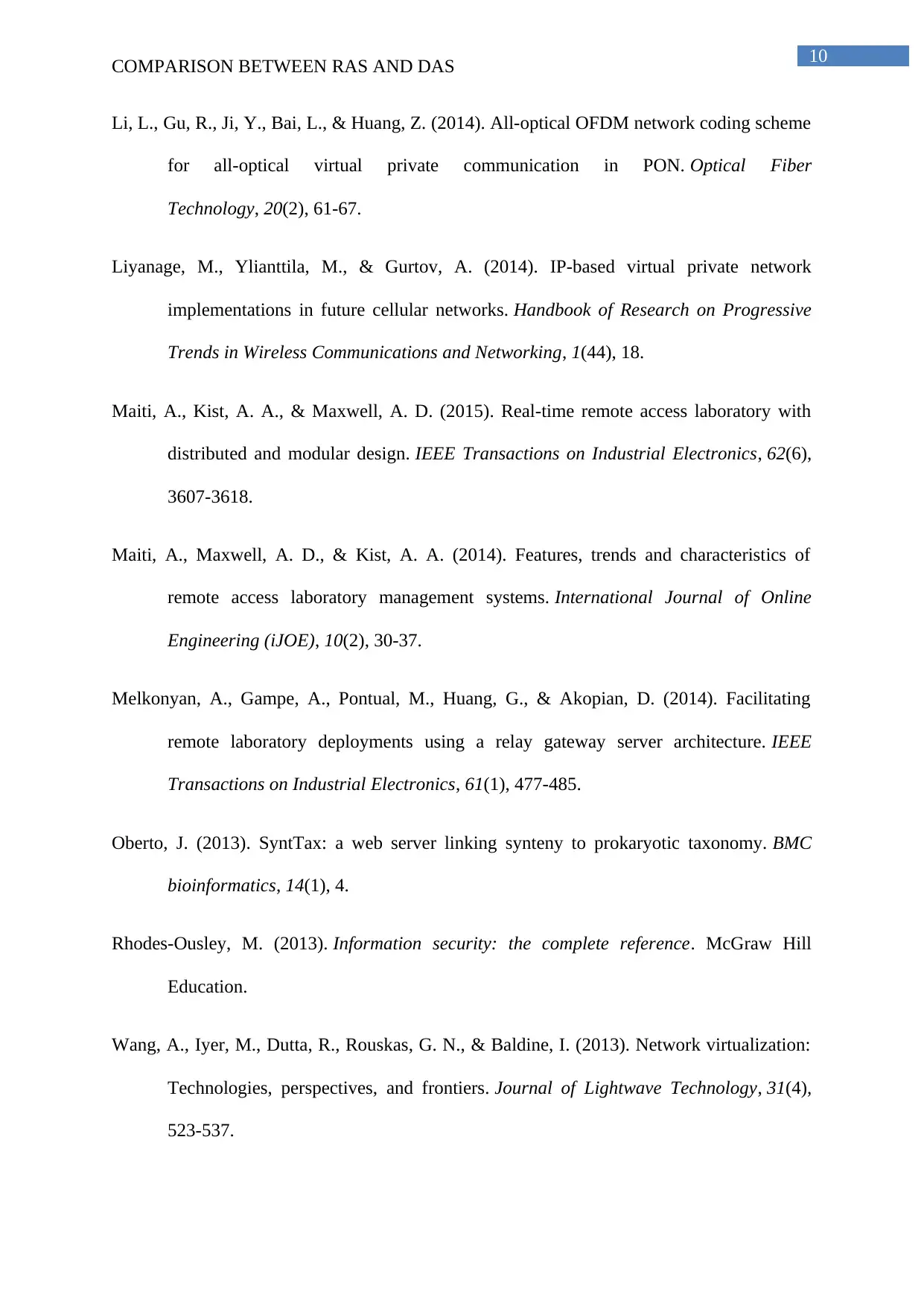
10
COMPARISON BETWEEN RAS AND DAS
Li, L., Gu, R., Ji, Y., Bai, L., & Huang, Z. (2014). All-optical OFDM network coding scheme
for all-optical virtual private communication in PON. Optical Fiber
Technology, 20(2), 61-67.
Liyanage, M., Ylianttila, M., & Gurtov, A. (2014). IP-based virtual private network
implementations in future cellular networks. Handbook of Research on Progressive
Trends in Wireless Communications and Networking, 1(44), 18.
Maiti, A., Kist, A. A., & Maxwell, A. D. (2015). Real-time remote access laboratory with
distributed and modular design. IEEE Transactions on Industrial Electronics, 62(6),
3607-3618.
Maiti, A., Maxwell, A. D., & Kist, A. A. (2014). Features, trends and characteristics of
remote access laboratory management systems. International Journal of Online
Engineering (iJOE), 10(2), 30-37.
Melkonyan, A., Gampe, A., Pontual, M., Huang, G., & Akopian, D. (2014). Facilitating
remote laboratory deployments using a relay gateway server architecture. IEEE
Transactions on Industrial Electronics, 61(1), 477-485.
Oberto, J. (2013). SyntTax: a web server linking synteny to prokaryotic taxonomy. BMC
bioinformatics, 14(1), 4.
Rhodes-Ousley, M. (2013). Information security: the complete reference. McGraw Hill
Education.
Wang, A., Iyer, M., Dutta, R., Rouskas, G. N., & Baldine, I. (2013). Network virtualization:
Technologies, perspectives, and frontiers. Journal of Lightwave Technology, 31(4),
523-537.
COMPARISON BETWEEN RAS AND DAS
Li, L., Gu, R., Ji, Y., Bai, L., & Huang, Z. (2014). All-optical OFDM network coding scheme
for all-optical virtual private communication in PON. Optical Fiber
Technology, 20(2), 61-67.
Liyanage, M., Ylianttila, M., & Gurtov, A. (2014). IP-based virtual private network
implementations in future cellular networks. Handbook of Research on Progressive
Trends in Wireless Communications and Networking, 1(44), 18.
Maiti, A., Kist, A. A., & Maxwell, A. D. (2015). Real-time remote access laboratory with
distributed and modular design. IEEE Transactions on Industrial Electronics, 62(6),
3607-3618.
Maiti, A., Maxwell, A. D., & Kist, A. A. (2014). Features, trends and characteristics of
remote access laboratory management systems. International Journal of Online
Engineering (iJOE), 10(2), 30-37.
Melkonyan, A., Gampe, A., Pontual, M., Huang, G., & Akopian, D. (2014). Facilitating
remote laboratory deployments using a relay gateway server architecture. IEEE
Transactions on Industrial Electronics, 61(1), 477-485.
Oberto, J. (2013). SyntTax: a web server linking synteny to prokaryotic taxonomy. BMC
bioinformatics, 14(1), 4.
Rhodes-Ousley, M. (2013). Information security: the complete reference. McGraw Hill
Education.
Wang, A., Iyer, M., Dutta, R., Rouskas, G. N., & Baldine, I. (2013). Network virtualization:
Technologies, perspectives, and frontiers. Journal of Lightwave Technology, 31(4),
523-537.

11
COMPARISON BETWEEN RAS AND DAS
COMPARISON BETWEEN RAS AND DAS
⊘ This is a preview!⊘
Do you want full access?
Subscribe today to unlock all pages.

Trusted by 1+ million students worldwide
1 out of 12
Your All-in-One AI-Powered Toolkit for Academic Success.
+13062052269
info@desklib.com
Available 24*7 on WhatsApp / Email
![[object Object]](/_next/static/media/star-bottom.7253800d.svg)
Unlock your academic potential
Copyright © 2020–2025 A2Z Services. All Rights Reserved. Developed and managed by ZUCOL.